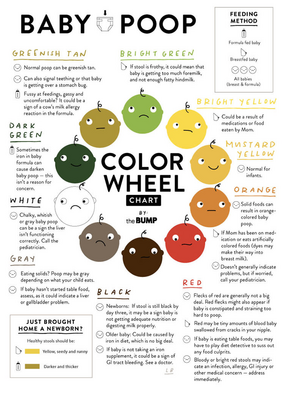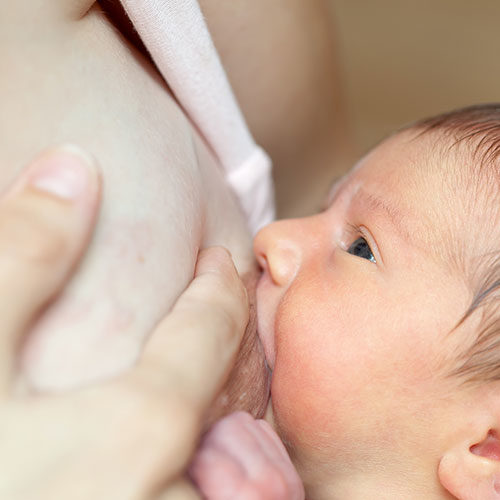What is normal and not normal Poop consistency in a breastfed baby?
Importance of baby’s stool :
A baby’s stool can indicate a lot of things through its quantity, color, texture etc. Some of the things that can be determined by poop are as follows –
- Whether or not the baby is getting enough
- Baby’s gut health
- Type of feeding
- Existence of some allergies
- Existence of some infections or illnesses
- A side effect of some medication
- Reaction to specific food items in the mother’s diet (for babies younger than 6 months) and their own diet (for babies having solids)
- Others
A. Poop and whether or not the baby is getting enough
The color, texture, quantity, and number of times a baby passes stool can indicate whether or not the baby is getting enough milk. The parameters change as per the baby’s age.
1. The first week –
The Baby’s first stool should be passed within 24 hours after birth. On the first couple of days, the stool is black. This is called meconium. It’s the black substance collected in a baby’s intestines during pregnancy. The more efficient the breastfeeding, the faster the meconium transforms into green and then mustard yellow stools. The frequency of stool, like that of urine, increases every day. Once on day 1, twice on day 2, and so on. By day 5, the mature milk has come in, and the stools must become mustard yellow in color. The consistency is often pasty to watery. The texture is seedy or curdy. Baby must now pass stools at least 3-4 times in 24 hours. More than that is also fine. And the size should be of a circle formed by joining our thumb and index finger.
2. Till 4 – 6 weeks –
The colour remains mustard yellow and the texture stays seedy. Babies must poop multiple times a day. Some babies may pass stools up to 10-15 times in the first few weeks. It is normal and should not be mistaken for diarrhea. Diarrhea in exclusively breastfed babies is rare.
3.After 4 – 6 weeks –
After the age of 6 weeks, the poop count comes down in many babies. Some babies may then poop only once in 7 days, which is normal. An exclusively breastfed baby can go up to 10 days without pooping as well, after the age of 6 weeks. And some babies may poop 7 times a day. Anything in this range is ok and does not indicate less intake.
B. Baby’s gut health
For babies less than 6 months old, who are growing well, green color poop may indicate a rapid transit through the baby’s gut as per renowned IBCLC Dr. Jack Newman.
C. Type of feeding
Breastfed babies have mustard yellow color poop whereas it is common to pass green/brownish stools for formula-fed babies. The consistency is also different. Formula-fed babies pass pastier stools. Their poop smells more pungent than breastfed babies.
D. Existence of some allergies
Certain allergies show up as blood streaks in the baby’s poop. E.g. CMPA (cow’s milk protein allergy). Even lactose intolerance can cause blood streaks in the stool.
E. Existence of some infections or illnesses
Common cold and cough can cause green, frothy, runny, mucousy stools. Gallbladder problems can cause gray stools. Liver problems can cause gray or white stools.
F. Side effects of medication
Iron supplements can cause darker colored poop like dark green, greenish-black.
G. Reaction to specific food items in mother’s or own diet
Some babies may be sensitive to certain food items in the mother’s diet and may react to it by developing loose motions, frothy poop. There may be changes in the poop color as well. After the age of 6 months, once the solids are introduced, the color and texture of the poop occasionally may change according to certain specific food items eaten by the baby. E.g. food items rich in iron may cause darker colored poop.
Blood in Stool
Blood in the stool of a baby can be due to many reasons. Some of them include the following.
- Anal fissure
- Dairy and other food sensitivity
- The cracked nipple of the mother
- Mother‘s oversupply causing lactose overdose
- Temporary lactose intolerance
6. GI tract infection or other intestinal disorders
Green Stools
Green stools can indicate one or more of the following.
- The baby is fed formula
- Foremilk hindmilk imbalance
- Oversupply
- Low supply
The following image can be useful in determining the meaning of different colored poops.

Wish to speak with a member of our team who is a certified lactation professional and also an experienced breastfeeding mother, click on this link.
Medical Advice Disclaimer
THIS WEBSITE DOES NOT PROVIDE MEDICAL ADVICE.
The information, including but not limited to, text, graphics, images and other material contained on this website are for informational purposes only. No material on this site is intended to be a substitute for professional medical advice, diagnosis or treatment. Always seek the advice of your physician or other qualified health care provider with any questions you may have regarding a medical condition or treatment before undertaking a new health care regimen, and never disregard professional medical advice or delay in seeking it because of something you have read on this website.
Disclaimer
We understand and acknowledge that parents and babies can be of various genders on a spectrum of LGBTQI+. Families come in diverse flavours. However, in our articles, for the sake of simplicity and convenience, we will be referring to the breastfeeding parent as the mother and using the female pronouns- ‘she’ and ‘her’ for babies. Babies can be nourished and nurtured in different ways and while we have used the terms breastfeeding and nursing, we recognize that parents can opt to chest feed or finger feed.
We don’t have conflicts of interest and declare, and we are compliant with the WHO code of marketing of breastmilk substitutes and the IMS act.
In case you find any information on this website that needs to be updated, please write to us at info@bsim.org.in






